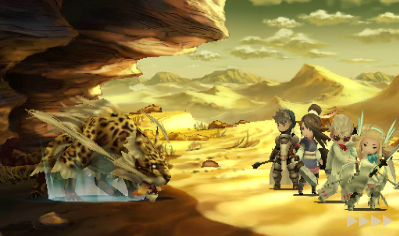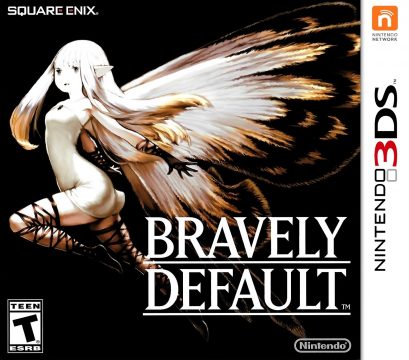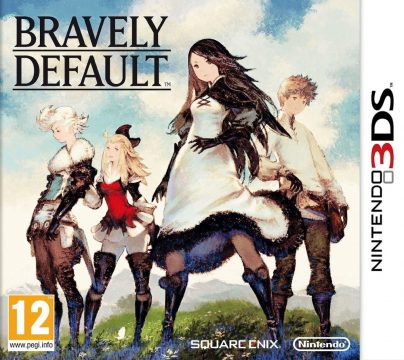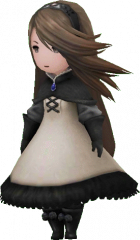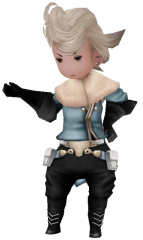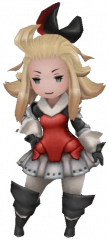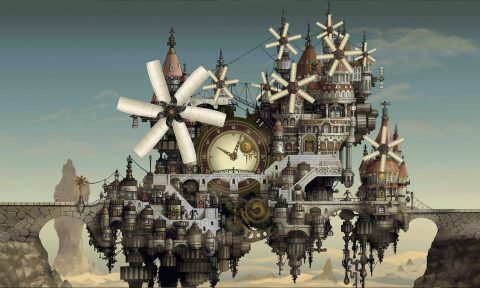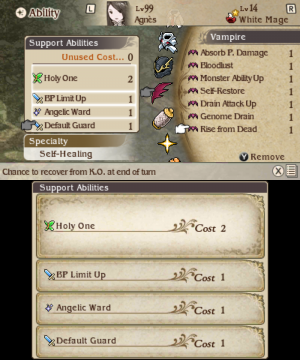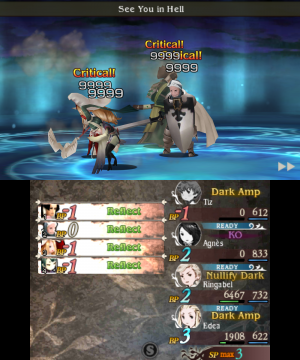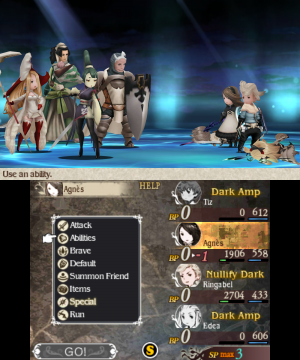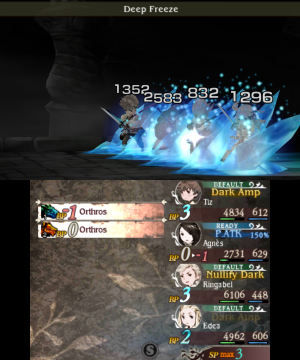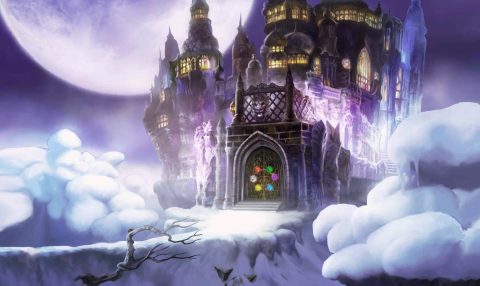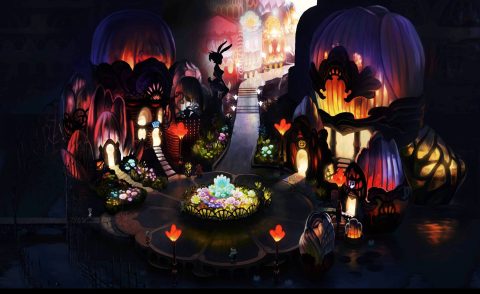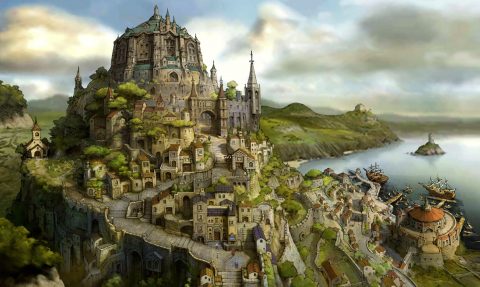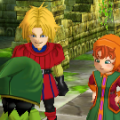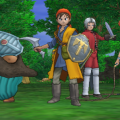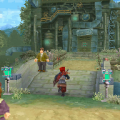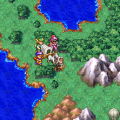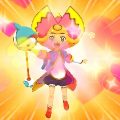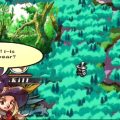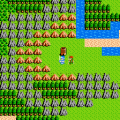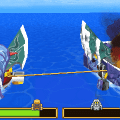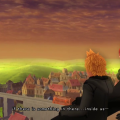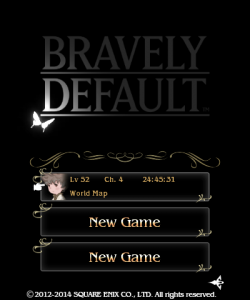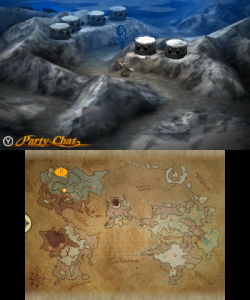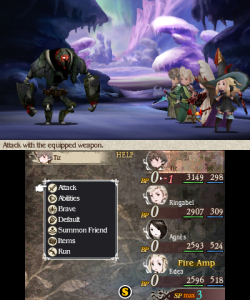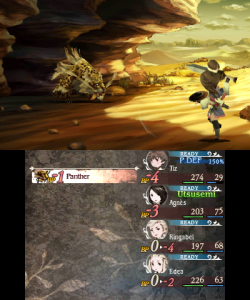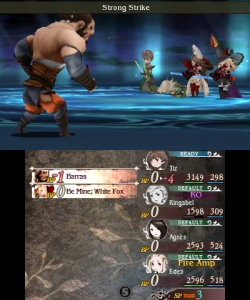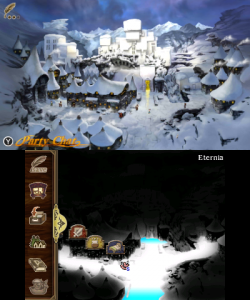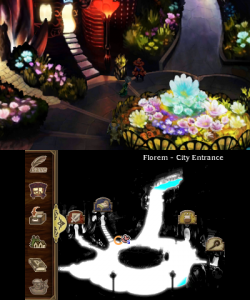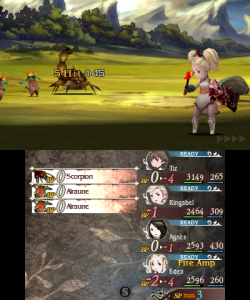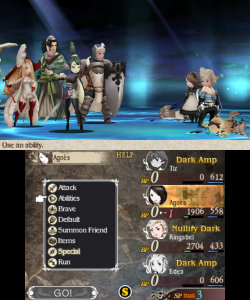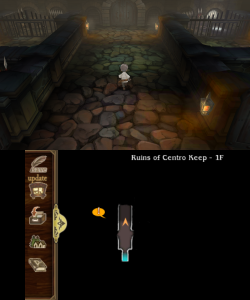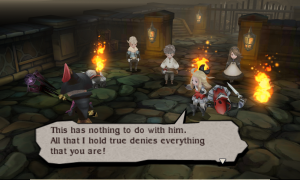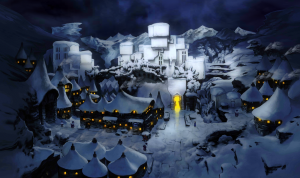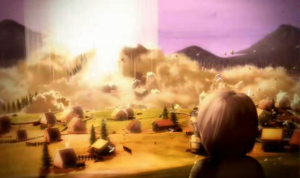Final Fantasy is one of Square-Enix’s most popular series, and they’ve been keen to keep it in the limelight. Along with various ports and upgrades of the first two NES games, in 2006 the team decided to create a full 3D remake of Final Fantasy III for the DS (later released on the PSP and elsewhere), then later Final Fantasy IV. The experience with these led the producer, Tomoya Asano, to helm a brand new, retro-style RPG called Final Fantasy: The 4 Heroes of Light. While this didn’t exactly set the world on fire, team Asano continued onward with Bravely Default, which inherits many elements of the Final Fantasy series, particularly the job system of Final Fantasy V. But it’s much more than just a spinoff, as this new game is uniquely characterized by an innovative battle system that enhances the pacing and stakes of each fight.
Visually Bravely Default continues along the line of its predecessors, with character artwork by Akihiko Yoshida. Newly joining along for the soundtrack is composer Revo, the leader of rock-orchestra band Sound Horizon, largely known for their vocal themes for the anime adaptation of Attack on Titan. This gives a very different musical style that sets it apart from not only its forebears but RPGs in general. And the story was written by Naotaka Hayashi, who also supplied the stories to several Science Adventure visual novels like Steins;Gate, again injecting some flesh blood into the formula. However the game still shares a lot in common with the Final Fantasy series in its story structure or theming. Having a job system closely related to Final Fantasy V’s, and a plot setup that’s a bit generic and unassuming, but with its fair share of unique twists and turns to diverge from a typical Final Fantasy game.
The plot of Bravely Default revolves around four heroes who have to restore the four elemental crystals of the land to save it from darkness. On the surface this sounds rather cliché but the story quickly gets sidelined by much more interesting plotlines of a corrupt army, shadowy motives, ancient prophecies of destruction, and time traveling-dimension hopping antics that form together to create a larger, more confusing puzzle.
Characters:
Tiz Arrior
A humble villager of Norende, who watched his entire life slip away before his very eyes, and his younger brother slip from his hands as a great chasm opened up below his home, leaving him as the only survivor.
Agnés Oblige
The current Vestal of Wind. Vestals are a long-standing tradition of the Crystal Orthodoxy (the group that maintains the 4 elemental crystals’ power). They are highly sheltered and trained to channel their energy into their respective crystal; maintaining and caring for the crystal so that it doesn’t break or become shrouded in darkness. When a crystal is overwhelmed with dark power a Vestal is required to perform a Rite of Awakening to revive the crystal, which is what Agnés has to single handedly manage as one of the few remaining Vestals at the start of the story.
Ringabel
Ringabel is a mysterious traveler who arrived at the port city of Caldisla without any recollection of his memory or identity mere days before the events unfolding at Norende. However, he holds a mysterious black journal with the letter “D” engraved on it, depicting events that have yet to transpire, and giving a few clues to who he was in the past. Throughout the game D’s journal will conjure new entries as the story progresses to hint towards future events that don’t quite always play out as they’re written.
Edea Lee
Edea Lee is an important member of the Sky Knights of Eternia, a vast militaristic army that spans across the world, enforcing its anti-crystalist philosophy on many of the major regions. Edea is the daughter of Braev Lee, leader of the Eternian force. She is sent out on a journey to capture the Wind Vestal, where she witnesses the cruelty of the Eternian army and decides to defect and assist the rest of the team on their journey to revive the crystals.
The rest of the game leads the party across the land to revive the four crystals, each in their own environment somewhat corresponding to their element, with appropriately themed cities such as the windy desert of Ancheim, or the snowy city of Eternia.
Along the way our heroes will encounter many bosses, the Eternian Commanders who are all uniquely characterized as much as the main party. Each encounter with these great foes shows insights to their personality, motivations, and sometimes allows you to empathize with them. Nevertheless the Eternian Commanders are violently opposed to your mission and must be fought, leading to some of the most fun and strategic battles in Bravely Default.
Here is where the combat truly shines, revolving around “Brave” and “Default” commands. Braving allows one of your party members to take a loan on up to four actions in a single turn, allowing an entire party 16 actions at once if desired. The catch is that you then need to wait an extra turn for each action you took- which is where Defaulting comes in, allowing you to instead defend and bank up to 3 extra turns so when you full Brave you’ll be set down to the standard 0 BP (what the game tracks to measure your action deficit).
This just scratches the surface on combat, as the class system eventually unlocks some ludicrously powerful abilities if they’re used correctly. Most classes specialize in unique abilities or weapons (a Knight to defend your team, a Summoner to deal group magic damage, a White Mage for healing, etc.) allowing the player to equip any party member with a variety or gear and synergize their whole party together around one central build, as opposed to a rigid class system seen in other JRPGs.
Nothing’s stopping you from turning your entire party into Ninjas with dual katanas that each hit 16 times per attack, who are also all properly setup at low HP to utilize another class move that enables the entire party to attack at once all for the cost of one action. Making your “one turn” into four, and if your entire party Braves while spamming Mass Attack… well, the final boss across multiple phases is dead in a single turn from 1000 sword slashes, having the combined potential to deal up to 12 million damage before the boss can even breathe. That is the beauty of Bravely Default’s combat.
There is a vast potential in build variety, which is not always common for JRPGs at this level of absurdity. The potential in the combat system is what makes the game truly fun, you’re always unlocking new abilities and classes that allow the player to experiment further and further until they reach a new apex setup; nothing is truly unviable, you just have to use it right. Which is necessary for the late game since it’ll throw some incredibly tough fights your way in terms of Trio or Quad boss fights, which group together bosses that were sometimes already difficult enough to fight on their own, who are able to synergize together and demolish your team in a single turn without the proper setup.
The Quad boss fights are the epitome of the game’s boss designs, pushing the player to their absolute limit in both pre-planning strategy and improvised combat. You can win with your knowledge and skills, without having to resort to complete broken cheese strats, which makes these fights so incredibly satisfying.
Some boss fights are not so stellar, some bosses have group attacks that can one-shot your entire party, others have multiple turns in a row where they can make your entire party weak to a certain element then use a single group element attack to wipe the party without you ever having a chance to counter it. Some fights are pure RNG, and in the early to mid-game they are quite the frustrating challenge, but you always have the means to defeat these bosses if you strategize hard enough.
You may be wondering how you’re able to refight all of Bravely Default’s many bosses in a gauntlet of pain, this is actually a major plot point in the story. For unknown reasons to the player, once all four crystals are linked the party is sent back in time to before any of the crystals were awakened. This contributes to the greater mystery of what the Eternian Army is actually trying to prevent by destroying the crystals, but offers sparse answers and leaves the party with an underlying sense of unease. Especially since every world seems different in odd ways and certain bosses act differently than they used to, making them more redeemable people.
Unfortunately, this is where the game starts to get a little repetitive, since you have to reawaken all of the crystals again (albeit with all your stats and an airship, so its doesn’t take nearly as long as the first time), and the story that used to deliver consistent and satisfying story beats is now thinly spread over many re-playthroughs of the main story, where almost no plot is advanced besides at the start and end of a loop. This leads the game to pose many new questions, but offer few answers until the final few hours, leaving the story to be more confusing and unsatisfying to experience than it needed to be. The problem is exacerbated by around 80% of the side content throughout the entirety of all the future timelines offers no actual story development amongst the many bosses that you can refight, which is the bulk of side content. The game misleads the player in the second timeline with lots of extra dialogue from these bosses, and hints that these fights will lead to a greater arc with all of these characters, but it doesn’t end up culminating into anything and their personalities essentially disappear once they get condensed down into multifights.
What you’re left with is a 20 hour game stretched out through empty content (if you choose to do everything). However the initial playthrough is where the game is at its strongest, and there is still that 20% of really good side content hidden in-between all of the generic boss refights. Most of that content is unique bosses and other secrets that can be discovered only after the first loop, otherwise the repeat side content is not worth slogging through as it heavily drags down the pacing that used to be excellent before it got introduced.
Bravely Default is still an amazing game despite the mixed story, supported by its beautiful painted aesthetic and high quality music. Each area can pan out to reveal a large gorgeous backdrop, and the music matches the scale of the epic journey with its blaring symphonic instruments in both cities and the overworld- giving a mixed feeling of grandiose with an underlying melancholy, but unwavering determination in these characters to persevere through their journey. The art and music complete Bravely Default, each city is so lush with personality, every cave dripping with a somber atmosphere, and every dungeon feeling like a tactical incursion.
Without cities such as Florem, such a visually and audibly distinct area that truly feels like an exotic city without needing any subtext – or the vibrant and gloomy volcanic city of Eisenberg, that’s somehow bolstered with hope and determination despite losing a civil war on top of living next to an active volcano, this world would feel all too the same. The journey would feel less impactful if not for these distinct areas immersing you into their culture. Which is something that the music alone is able to achieve, and is further enhanced by the strong visual design.
Aside from this is a minigame that involves rebuilding the town of Norende. This mostly happens automatically, though you could set the 3DS StreetPass to get help from other passing players. New residents will set up shops that let you buy items you wouldn’t normally able to get. Years after its release, almost no one is carrying 3DS consoles around on them, so this function is mostly deprecated. You can still participate but it takes many, many real time days to populate your town.
Do yourself a favor and play Bravely Default, although the game is currently stuck on the 3DS exclusively, it’s an incredible JRPG from a gameplay, visual, and musical standpoint. At least give a listen to its outstanding soundtrack if you need any more influencing.
Bravely Default was initially released in 2012 in Japan, which was followed up by a revised version in 2013 subtitled For the Sequel. Beyond bug fixes, balance tweaks, and some additional content, the biggest addition here is the ability to turn off random encounters completely. Obviously you can’t go through the whole game like this, because you won’t level up your characters and end up getting thrashed in boss fights, but it helps customize your gameplay experience, if you’d rather spend some time exploring rather than fighting. You can also speed up the battles to 2x or 4x, which makes them go by in a blaze. Both of these features make the second part of the game go by much faster. Also included is a new Bravely Second function which lets you exceed the 9999 HP damage limit. This is the only version that was released internationally, though it’s missing the For the Sequel subtitle.
Bravely Default spawned two more sequels, Bravely Second: End Layer & Bravely Default II, alongside a few minor mobile/web game spinoffs that are now defunct and Japan exclusive. Second is more of a direct sequel, while Default II separates itself from the original storyline, giving players who have no way of playing the original a chance to experience the series.
